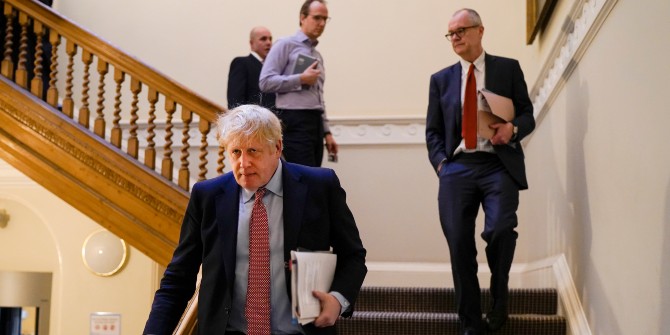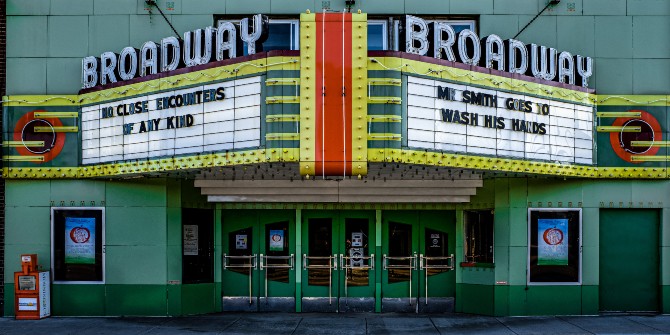The ‘support bubble’ is a new legal concept that has emerged during the pandemic. Sarah Trotter (LSE) looks at how it brought together a range of relationships and then recast them in terms of a new legal form.
One of the most fundamental debates in family law concerns the definition of ‘family’. Who counts as a ‘family’ in law, on what basis, and with what effects? Historically, the answer to this question was dominated by the nuclear family — and it remains the case that family law is still oriented around this unit in practical and conceptual terms.
In English and Welsh family law, for example, the focus is very much on the structures of marriage, civil partnership, and parenthood, with other relationships – including with siblings, grandparents, and extended family members – attracting far less legal attention. In response to this perceived lack, a rich literature has arisen, arguing that family law should concern itself more with practices of care that transcend familial relationships, as well as relationships that it has overlooked more generally — including friendships.
The point is an interesting one, because it brings to the fore deeper questions about the personal relationships that matter in (and according to) law, and the way in which these relationships are legally constructed. Even the slightest consideration of the very idea of legally recognising and regulating friendship, for instance, raises a multitude of questions about the form that this would take.
The aim was to capture the containment and protection required during the pandemic, and to do so in an empowering way
The emergence of the concept of the support bubble during the pandemic stands out as a particularly interesting legal development because of the way in which it drew in, and built on, a range of relationships and then recast them in terms of a new legal form. It involved, in other words, the legal construction of a particular way of relating. This was precisely the point: when the concept was introduced in New Zealand in March 2020, it was specifically to denote an exclusive network of people with whom a person could have physical contact.
Before the onset of the pandemic, and the disruption that it unleashed on ways of thinking about, relating to, and being with one another and ourselves, there was no notion of a support bubble. The aim, according to Tristram Ingham, who came up with the idea of the bubble, was to capture the containment and protection required during the pandemic, and to do so in an empowering way. A bubble was an apt metaphor in that respect, being a “fragile yet beautiful structure that has to be nurtured and preserved”.
Initially, in New Zealand, this network was largely household-focused: with some exceptions (for instance, for those living alone, or sharing childcare across two households) people were instructed to conceive of anyone they were living with as constituting their bubble. Later on, ‘extended’ bubbles became possible, enabling residents to expand their bubble to bring in close family, whānau (an extended family or community of related families), caregivers, and isolated people. Throughout, however, the critical point remained the principle of exclusivity: people were to remain within and maintain their bubble once it had been established, and to keep their distance from anyone outside it. The concept of the bubble reflected, in this way, the essence of two basic imperatives that structured life in this period: of being together apart and being apart together.
The notions of containment and protection that had underpinned the bubble concept in New Zealand influenced the versions that were eventually introduced in the UK from June 2020 as part of lockdown easing. Support bubbles were presented as a way of alleviating some of the worst effects of the loneliness, isolation, and separation involved in the original lockdowns. The aim was to permit increased cross-household contact, particularly for those identified as having the greatest need, while limiting the risk of spreading COVID. While the versions of the concept that were constructed in England, Scotland, Wales, and Northern Ireland all differed slightly, the focus in all cases was primarily on those living alone, parenting alone, or caring alone. As in New Zealand, the dominant principle of the bubble in the UK was that of exclusivity, and the maintenance of a distance between bubbles (in spatial and temporal terms) was treated as an act of care.

The concept of the support bubble raised questions that had not been addressed before. What did it mean to be in a bubble together? What did it mean to relate in this way? Answers to these questions, and experiences of bubbles, would inevitably differ according to individual circumstances and household composition, but in both New Zealand and the UK the question of the meaning of being in a bubble was in part a legal one. In these cases, a form of relating was legally constructed, and real relationships were affected through law.
It enabled some ways of being together, and excluded others; it took some ways of being together, and recast these in a new legal form
Two points are especially notable. The first is the range of household and cross-household relationships that were implicated. These would not ordinarily have been categorised together or treated as comparable in law. The linking of bubbles to households drew together a range of household relationships between family members, friends, and relative strangers who happened to be living together. For those who were eligible to form cross-household bubbles, the construct similarly enabled a diverse range of relationships. In the UK, for instance, those who were eligible were essentially able to define the meaning and nature of a support-bubble relationship themselves. The framework within which this had to be done was tight, and it reflected a series of assumptions about needs and vulnerabilities; which needs counted; who had those needs; and the meaning of support itself. Those eligible nevertheless had a hypothetical degree of freedom with regards to the composition of their bubble. The intention was that bubbles would be formed with family members, partners, loved ones, or friends — and it seems that, mostly, they were — but this was not a requirement.
Secondly, through the concept of the support bubble, some kinds of relationships that had not necessarily attracted much previous legal attention – like friendships and dating relationships – came to find a space in which they were accorded a degree of legal reflection and recognition. The concept of the support bubble presented an interesting case in this sense, and a notable development when considered in relation to the debates highlighted earlier about the relationships that have historically been overlooked in family law.
As a legal form that was exclusively focused on a certain idea of support, the concept of the bubble drew in and built on existing relationships, created a possibility for new relationships to develop, and was itself a new way of being together. This raises the question of the longer-term implications of the concept. Looked at from the perspective of debates about the legal regulation of close relationships, it carried a disruptive potential. This is because of the way in which it brought together relationships that would not ordinarily have been categorised together or treated as comparable as a matter of law, but also because it created some space for relationships that are not ordinarily accorded much legal recognition, such as friendships. At the same time, the concept of the bubble served as a reminder of the disruptive potential of the law itself for the lived reality of these same relationships. It enabled some ways of being together, and excluded others; it took some ways of being together, and recast these in a new legal form.
This post represents the views of the author and not those of the COVID-19 blog, nor LSE. It is based on Ways of Being Together During the COVID-19 Pandemic: Support Bubbles and the Legal Construction of Relationships, Frontiers in Sociology, 2 September 2021.





